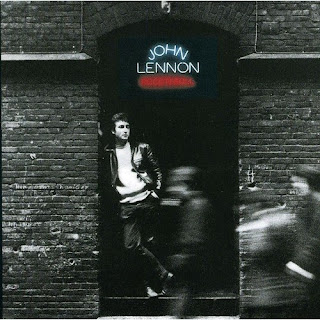Here's my piece about a true story set in Nashville in 1987. It was published in the Richmond Times-Dispatch on Jan. 7, 2017, under the title, “Shredding magazines, dying comets, and John Lennon.” My title for it was “Giving Peace a Chance,” but they didn't opt to use it. For those who can't see the piece at the RT-D (link above), the text is below.
*
With the recent passing of the 44th anniversary of his death, I couldn’t help but wonder what the founder of The Beatles — John Lennon, a master of word-play and sarcasm — would have to say about today’s music, art and politics. It would be anybody’s guess. After all, in his nearly 20 years as a public figure Lennon’s knack for changing before our eyes was dazzling. There’s no reason to think such a restless soul wouldn’t have kept on changing ... and commenting.
In February 1964, The Beatles made their initial appearances on the Ed Sullivan Show. Those two Sunday nights were less than three months after the assassination of President John F. Kennedy. Surely, the somber mood of the nation, still trying to regain its balance, had something to do with why those fresh-sounding Beatles tunes cut through the fog of melancholia with such verve. Notably, there’s been no explosion in American pop music since then equivalent to the impact of Liverpool’s Fab Four.
Then, on Dec. 8, 1980, the murder of moody John Lennon had an impact on the public few would have predicted. It was as though a world leader, or a family member, had been gunned down on the street in Manhattan.
Lennon’s obvious contributions as a songwriter and musician were huge. Yet, it was his sense of humor and delight in taking risks that really set him apart from many of his celebrity counterparts, some of whom toyed with politics and social causes as if they were hairdos or dance crazes.
With the Vietnam War still underway in the early ’70s, President Richard M. Nixon looked at Lennon and saw in him a charismatic working-class hero with the power to galvanize a generation’s anti-establishment sentiments. Fearing such potential, the Nixon administration did everything it could to hound Lennon out of the USA.
The details of that nasty little campaign are just as bewildering as some of the better known abuses that flowed from the Dirty Tricks Department in the White House during those scandal-ridden days.
With so many years of perspective on Lennon’s death, it seems to me now that even if that particular gunman (a person I choose not to name because I refuse to add in any way to his celebrity) hadn’t pulled the trigger, it could easily have been another one. Like the comets of each generation are bound to do, sometimes Lennon burned too bright for his own good.
Accordingly, with assassinations in mind, I’m reminded of a news item that ran in the Nashville Banner on Feb. 24, 1987.
The article’s lede was this: “Two Nashville musicians remained free on $500 bond today after they went on a magazine-shredding tear ... to protest People magazine’s current cover story.”
The two musicians were Mike McAdam and Gregg Wetzel. As members of the Good Humor Band they were fixtures in Richmond’s rock ’n’ roll scene in the late ’70s and early ’80s.
By the time of the attacks on the magazines, the pair had moved on and established themselves as respected sidemen in Nashville — McAdam on guitar and Wetzel on piano.
In a nutshell, Mike and Gregg became incensed at seeing the magazine with a cover story about John Lennon’s murderer. They felt spotlighting the killer in that way might encourage another deranged wannabe to take gun in hand to hunt down another comet.
So the boys fortified themselves with an adequate dose of what-it-takes — legend has it they were drinking out of an Elvis decanter — and set out on a mission to destroy the cover of every copy of the offensive publication that they could find on the strip.
Naturally, this sort of endeavor is best undertaken in the wee hours. In the course of their fifth stop, at a Nashville convenience store, the avenging angels were apprehended by the cops and charged with “malicious mischief.”
Shortly afterward, in a interview about the incident, McAdam said, “If another guy like (name withheld again) sees that, he might think he can get on the cover of People magazine by killing a politician or artist.”
Bravo!
Primary among the reasons John Lennon was selected and stalked by his murderer was that Lennon did indeed have a rare ability to move people. In that sense, he was slain for somewhat the same reason as political figures such as Martin Luther King and Robert F. Kennedy. Two thousand years ago, wasn’t Jesus Christ taken out of the game for much the same reason?
It’s always been dangerous to challenge the established order. To risk changing. To give peace a chance. Indeed, we may be entering an era in which questioning the wisdom of the powers that be will become increasingly more dangerous.
Wouldn’t it be fun to hear what Lennon would have to say today about our rather mock-worthy president-elect?
Although Nixon miscalculated Lennon’s intentions, the soon-to-be-disgraced president was probably right about his potential to focus the anti-establishment sentiments in the air. What Nixon didn’t grasp was that mischief streak aside, Lennon was generally more interested in promoting peace than fomenting revolution.
To flesh out the 36-year-old magazine-cover-shredding yarn, Wetzel recently added, “The cops looked at me and McAdam, decided we weren’t exactly flight risks and entrusted our transport to the pokey with an attractive female officer, all by her lonesome. On the way to the hoosegow, Mickey hit on the cop. True story.”
Peace.
-- 30 --
Note: The picture of Lennon (a 1975 album cover) in a doorway was borrowed from the Internet.


No comments:
Post a Comment